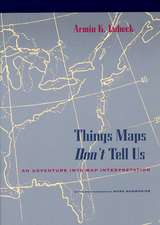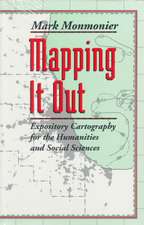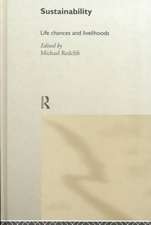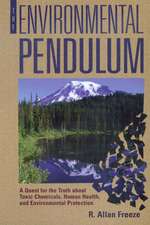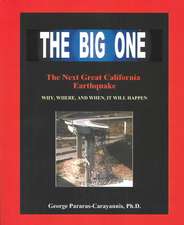Cartographies of Danger: Mapping Hazards in America
Autor Mark Monmonieren Limba Engleză Paperback – oct 1998
No place is perfectly safe, but some places are more dangerous than others. Whether we live on a floodplain or in "Tornado Alley," near a nuclear facility or in a neighborhood poorly lit at night, we all co-exist uneasily with natural and man-made hazards. As Mark Monmonier shows in this entertaining and immensely informative book, maps can tell us a lot about where we can anticipate certain hazards, but they can also be dangerously misleading.
California, for example, takes earthquakes seriously, with a comprehensive program of seismic mapping, whereas Washington has been comparatively lax about earthquakes in Puget Sound. But as the Northridge earthquake in January 1994 demonstrated all too clearly to Californians, even reliable seismic-hazard maps can deceive anyone who misinterprets "known fault-lines" as the only places vulnerable to earthquakes.
Important as it is to predict and prepare for catastrophic natural hazards, more subtle and persistent phenomena such as pollution and crime also pose serious dangers that we have to cope with on a daily basis. Hazard-zone maps highlight these more insidious hazards and raise awareness about them among planners, local officials, and the public.
With the help of many maps illustrating examples from all corners of the United States, Monmonier demonstrates how hazard mapping reflects not just scientific understanding of hazards but also perceptions of risk and how risk can be reduced. Whether you live on a faultline or a coastline, near a toxic waste dump or an EMF-generating power line, you ignore this book's plain-language advice on geographic hazards and how to avoid them at your own peril.
"No one should buy a home, rent an apartment, or even drink the local water without having read this fascinating cartographic alert on the dangers that lurk in our everyday lives. . . . Who has not asked where it is safe to live? Cartographies of Danger provides the answer."—H. J. de Blij, NBC News
"Even if you're not interested in maps, you're almost certainly interested in hazards. And this book is one of the best places I've seen to learn about them in a highly entertaining and informative fashion."—John Casti, New Scientist
California, for example, takes earthquakes seriously, with a comprehensive program of seismic mapping, whereas Washington has been comparatively lax about earthquakes in Puget Sound. But as the Northridge earthquake in January 1994 demonstrated all too clearly to Californians, even reliable seismic-hazard maps can deceive anyone who misinterprets "known fault-lines" as the only places vulnerable to earthquakes.
Important as it is to predict and prepare for catastrophic natural hazards, more subtle and persistent phenomena such as pollution and crime also pose serious dangers that we have to cope with on a daily basis. Hazard-zone maps highlight these more insidious hazards and raise awareness about them among planners, local officials, and the public.
With the help of many maps illustrating examples from all corners of the United States, Monmonier demonstrates how hazard mapping reflects not just scientific understanding of hazards but also perceptions of risk and how risk can be reduced. Whether you live on a faultline or a coastline, near a toxic waste dump or an EMF-generating power line, you ignore this book's plain-language advice on geographic hazards and how to avoid them at your own peril.
"No one should buy a home, rent an apartment, or even drink the local water without having read this fascinating cartographic alert on the dangers that lurk in our everyday lives. . . . Who has not asked where it is safe to live? Cartographies of Danger provides the answer."—H. J. de Blij, NBC News
"Even if you're not interested in maps, you're almost certainly interested in hazards. And this book is one of the best places I've seen to learn about them in a highly entertaining and informative fashion."—John Casti, New Scientist
Preț: 330.70 lei
Nou
Puncte Express: 496
Preț estimativ în valută:
63.28€ • 66.25$ • 52.36£
63.28€ • 66.25$ • 52.36£
Carte tipărită la comandă
Livrare economică 07-21 aprilie
Preluare comenzi: 021 569.72.76
Specificații
ISBN-13: 9780226534190
ISBN-10: 0226534197
Pagini: 378
Ilustrații: 2 halftones, 16 line drawings, 97 maps
Dimensiuni: 152 x 229 x 23 mm
Greutate: 0.54 kg
Ediția:1
Editura: University of Chicago Press
Colecția University of Chicago Press
ISBN-10: 0226534197
Pagini: 378
Ilustrații: 2 halftones, 16 line drawings, 97 maps
Dimensiuni: 152 x 229 x 23 mm
Greutate: 0.54 kg
Ediția:1
Editura: University of Chicago Press
Colecția University of Chicago Press
Notă biografică
Mark Monmonier is distinguished professor of geography at Syracuse University’s Maxwell School of Citizenship and Public Affairs.
Cuprins
Preface
Acknowledgments
1: Map Scale, Danger Zones, and Safe Places
2: Shaky Preparations
3: Lavas and Other Strangers
4: Uncertain Shores
5: Death Tracks
6: Floodplains, by Definition...
7: Subterranean Poisons
8: Ill Winds
9: Short-Lived Daughters and ELF Fields
10: Nuclear Nightmares
11: Imagining Vulnerability
12: Crimescapes
13: John Snow's Legacy
14: Emerging Cartographies of Danger
Notes
Index
Acknowledgments
1: Map Scale, Danger Zones, and Safe Places
2: Shaky Preparations
3: Lavas and Other Strangers
4: Uncertain Shores
5: Death Tracks
6: Floodplains, by Definition...
7: Subterranean Poisons
8: Ill Winds
9: Short-Lived Daughters and ELF Fields
10: Nuclear Nightmares
11: Imagining Vulnerability
12: Crimescapes
13: John Snow's Legacy
14: Emerging Cartographies of Danger
Notes
Index

